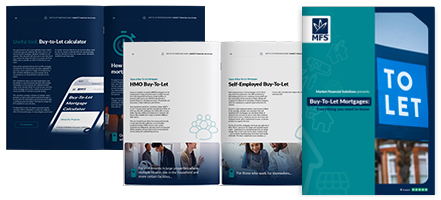Market Financial Solutions are a bridging loan and buy-to-let mortgage provider and are not legal, financial, investment or tax advisers. This document is for informational purposes only and does not, and should not be considered, to constitute legal, financial, investment or tax advice or be relied upon by any person to make a legal, financial, investment or tax decision. Therefore, Investors are encouraged to seek appropriate professional advice. The information in this content is correct at time of writing.

Much of the commentary focused on the property market at the moment is centred on how we need to build more homes. Regardless of whether you’re looking at the rental or buyer’s market, we’re not building enough new homes to keep up with demand.
It’s generally believed we need to build 300,000 homes per year to keep the balance between supply and demand steady. But we haven’t come close to hitting this number since at least the early 1970s[1], according to the Home Builders Federation. Nevertheless, a lot of time, effort, and resources has been put into creating new builds across the UK. The question remains though, is buying a new build a good investment?
Looking ahead, new builds will likely play a crucial role in the housing market. The current government plans to deliver 1.5 million new homes over the next few years[2], much of it likely to be built on “Grey Belt” land[3].
To help property investors understand how, or whether new builds should be a part of their investment strategy, we’ve put this blog together. We’ll explore how new build prices are faring in the current market, the pros and cons involved, and where opportunity may lie in the UK. However, before deciding whether any type of venture including buying a new build is a good investment, it would be wise to seek guidance from a professional advisor.
New build prices
New builds can come to the market at a relatively high price. The latest data from the ONS[4] showed the average new build in England was priced at £446,000 in early 2025. Comparatively, existing resold property sat around the £286,000 mark.
These high prices may make it difficult to generate a profit when the time comes to sell the property on. In fact, 1 in 8 new-build homes were resold at a loss in early 2023, according to analysis conducted by Hamptons estate agents[5]. Given more recent data shows property “flipping” has hit a 12-year low [6], it’s likely that many investing in new builds are still struggling to find suitable buyers.
Still, this doesn’t mean we have no buyers’ market at all in the new build world. Nearly half (48%) of homebuyers in 2024 expressed a desire to purchase a new build property, according to the Mortgage Advice Bureau[7]. This was 21% higher than the figures recorded in both 2022 and 2023.
Generally, the question of “Is buying a new build a good investment?” will be dependent on the size of one’s budget. If someone is investing in a new build, they’ll likely need a fair bit of capital.
The pros – energy efficiency, demand, government support
While the benefits or downsides of any investment will be dependent on individual circumstances, there are several potential upsides to buying a new build as an investment.
New builds can come fully furnished, which can aid with a BTL strategy. There may also be low maintenance costs in place as items such as boilers are new, along with a smoother buying process, with the property being empty. There are generally fewer chains involved with a new build purchase, minimising the chances of chain-breaks, gazumping, or gazundering.
Arguably though, one of the most important perks associated with new builds is their energy efficiency. In 2024, 86% of new builds had either an A or B EPC rating[8].
Buyers and renters alike are keen on all this. Some 70% of homebuyers are willing to pay a 10% premium for eco-friendly properties in the current market[9]. Meanwhile, a survey of investors revealed that 92% say tenants will pay more for greener homes[10].
This demand may only push higher over the coming months too. There are already several government schemes available to support investment in new builds. This includes the shared ownership[11], deposit unlock[12], and first homes schemes[13].

The cons – high costs, poor quality, nimbyism
While buying a new build investment can command a high premium, it also means there’s higher entry costs involved. And while a new build’s green credentials may bring in some buyers, separate snags may put many others off.
Developers have been accused of rushing their projects or building new homes cheaply. This can result in shoddy houses with multiple defects.
In late 2021, analysis from BuildScan found the average new build property came to market with as many as 157 defects[14]. Common examples included poor plastering, bad brickwork, and damaged windows. Fast forward to today, and it seems snagging issues are still a concern[15].
All this adds to the negative sentiment surrounding new build developments. They often face push back from nimbys[16], and many new builds are often dubbed “ugly[17]”.
Where can opportunity be found?
Regardless of whether one considers buying a new build a good investment or not, they may become at least a factor in future plans. The state is under immense pressure to build more homes.
So where could property investors look? Well, we know that Labour’s New Towns Taskforce has identified over 100 potential, undisclosed sites for new towns to be built[18].
While it hasn’t been confirmed where these towns will be based yet, the think tank UK Day One [19]recommended four sites to the government: Taplow in Buckinghamshire, Poppleton on the outskirts of York, and extensions on the borders of Manchester and Leeds.
Urbanist Architecture also identified 20 high-potential locations that offer a combination of strategic economic potential, existing infrastructure and transport links, and the capacity to evolve into self-sustaining, thriving communities[20]. This included around the Cambridge Area, the M1 Corridor around Milton Keynes, and the Thames Estuary (Ebbsfleet and surrounding areas).
If property investors are thinking about buying a new build as an investment, specialist lending may be able to help. Our bridging finance, along with our BTL mortgages, can be used for a range of new build properties. Should an investor find the right option for their circumstances, we’re only a phone call away.
The Complete Guide to
Buy-to-Let Mortgages
Everything you need to know
- Fundamentals
- Different mortgage types
- Useful tools
- Industry stats & more
[1] https://www.telegraph.co.uk/business/2023/05/25/britain-housing-crisis-new-builds-record-immigration/
[2] https://committees.parliament.uk/committee/17/housing-communities-and-local-government-committee/news/207213/15-million-new-homes-and-net-zero-by-2050-can-the-government-do-both-latest-episode-of-committee-corridor-podcast-tackles-the-housing-crisis/
[3] https://www.farrer.co.uk/news-and-insights/the-country-is-grey-and-brown-and-green-in-trees-labours-grey-belt-planning-reforms/
[4] https://www.gov.uk/government/news/uk-house-price-index-for-april-2025
[5] https://www.telegraph.co.uk/money/property/homeowners-lose-22k-one-eight-new-build-homes-resold-loss/
[6] https://www.ft.com/content/91af59a7-ce64-47eb-89d9-3eb99dee857b
[7] https://www.introducertoday.co.uk/breaking-news/2025/02/new-build-demand-surges-amongst-buyers-in-all-age-groups/
[8] https://www.hbf.co.uk/policy/wattasave/
[9] https://www.mirror.co.uk/money/household-bills/eco-upgrades-boost-home-values-35022217
[10] https://www.landlordtoday.co.uk/features/2025/06/tenants-will-pay-more-for-green-homes/
[11] https://www.gov.uk/shared-ownership-scheme
[12] https://deposit-unlock.co.uk/
[13] https://www.gov.uk/first-homes-scheme
[14] https://www.thisismoney.co.uk/money/mortgageshome/article-10258569/Our-new-build-nightmare-New-homes-average-157-defects.html
[15] https://www.bbc.co.uk/news/articles/cx20xj5n325o
[16] https://www.bbc.co.uk/news/articles/ce3l9jdy2q1o
[17] https://www.telegraph.co.uk/money/property/buying-selling/why-britain-ugly-new-builds/
[18] https://www.bdonline.co.uk/news/london-green-belt-development-could-include-new-towns-sadiq-khan-confirms/5136015.article
[19] https://inews.co.uk/news/four-locations-rayner-build-new-towns-3482722?srsltid=AfmBOoppQDZedN8Xc4LEKIOBH-b3nau3SOirfsUKoBBxnfo8PxNHrBes
[20] https://urbanistarchitecture.co.uk/location-new-towns-labour/






